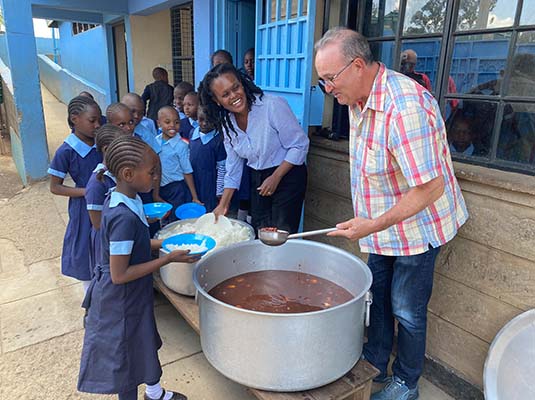November 2022
Dear Friends and Partners of KCEF’s mission in Kenya:
I joined the KCEF board shortly before Covid struck and the world shut down, so I’ve been delayed until this October in making a trip to Kenya to visit our schools. As I was preparing, one word—“hope”—kept coming to my mind.
I think we can all agree that we are in an enormous deficit of hope in America. Political divisions, the war in Ukraine, inflation and recession worries, lingering pandemic concerns, mass shootings—all these and more make it hard to be hopeful.
In Kenya, the list of worries is longer still, including a multi-year drought, Covid’s shutting down the vital tourism industry, and rapidly rising energy and food costs. You would think that, surely, hope would be in short supply there, especially in the slum of Kibera in Nairobi, where over a million people are crammed into an area the size of Central Park without running water or indoor plumbing and an unemployment rate near 50%. Surely, in Kibera, hope simply could not exist.
Or could it?
On our first school visit of the trip, we drove slowly through Kibera’s rutted, trash strewn streets filled with the smells of smoke, garbage and human waste, past a maze of corrugated tin shanties that stretch as far as the eye can see. Suddenly, an oasis appeared. Behind a clean blue and white gate that said Kicoshep School was a welcoming honor guard of Girl and Boy Scouts and two floors of clean classrooms filled with eager students.
It was as if the slums which came right up to the school walls did not exist in this miraculous sanctuary. Children were being fed, educated, and made to feel loved and safe all day, before having to make their way home through treacherous streets.
With all the support you have given KCEF, we have been able to assist the remarkable team at Kicoshep as they have grown their school. Today, we help provide daily meals, a full slate of classes that even includes computer instruction and HOPE for a much brighter future for the 350 children there.
As the week progressed and we continued our visits, it was clear that each of our other programs—Gentle Bells, Blessed Children’s Academy, Mawewa, Karem, Gospel Victory Academy and Penuel Transforming— offers a distinctive oasis of hope for children in the poorest parts of Kenya’s biggest city.
To give just one example of what your donations are accomplishing, we visited the home of Samson Singwa. Like most shanties in Kibera, his home is one 12 foot by 12 foot room with a curtain dividing the sleeping and living areas. Samson is a casual day laborer who has raised six children alone, as his first wife passed away and his second wife left him. All of his children have attended Kicoshep School, and three have graduated and moved on to high school. We helped support his promising eldest son, Nashon, with a scholarship to a private boarding school for high school and have continued to support him into university.
He is now back living with his father in Kibera as he completes his studies in electrical engineering at one of Nairobi’s top universities. Thanks to all the KCEF donors over the years, we have had the chance to not only change Nashon’s life, but the entire Singwa family along with him.
This trip was a chance to see firsthand the incredible hope you help provide to the poorest of the poor in Kenya, where we are committed to continuing our mission, despite dramatically rising costs. Programs like feeding our children remain vital to our mission, as the prospect of at least one nutritious meal a day is a powerful motivator for kids to stay in school. Unfortunately, costs for staples like rice, corn and beans have doubled in the last year.
Kenya is also in the process of converting from a K-8th grade and high school system to one more like the U.S., with a K-6th grade elementary school, followed by 7-9th grade middle school and then high school. There is going to be a terrible shortage of middle schools in poor neighborhoods, because adding middle schools will require investing in new classrooms and higher qualified teachers. Our school leaders are eager to embrace the challenges of the new system, but they need KCEF’s financial help to do so.
If you are a regular donor, would you please consider increasing your giving in the coming year? If you haven’t donated yet, know that your help now can make a vital difference in this time of transition. Our kids are counting on you to keep providing the gift of hope. Thank you for your support!
– Jud Reis, KCEF Board Member


